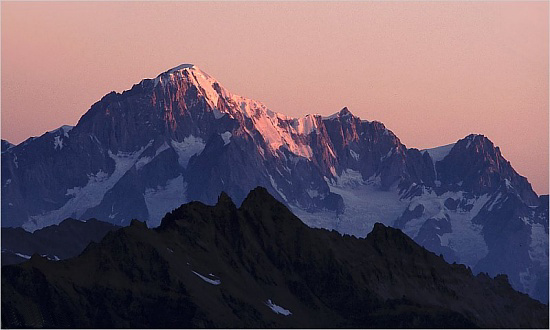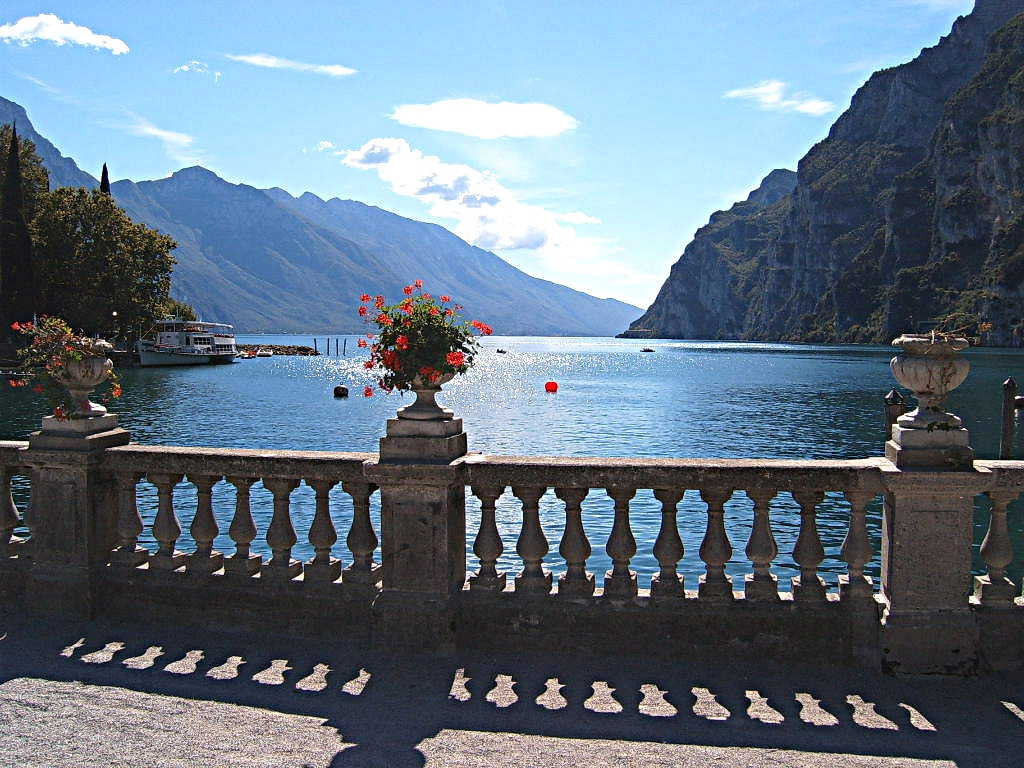Mont Blanc (Monte Bianco), the highest mountain in Italy and Western Europe.
Between the north and south there can be a considerable difference in temperature, above all during the winter: in some winter days it can be −2 °C (28.4 °F) and snowing in Milan, while it is 8 °C (46.4 °F) in Rome and 20 °C (68.0 °F) in Palermo. Temperature differences are less extreme in the summer.
The east coast of the italian peninsula is not as wet as the west coast, but is usually colder in the winter. The east coast north of Pescara is occasionally affected by the cold bora winds in winter and spring, but the wind is less strong here than around Trieste. During these frosty spells from E–NE cities like Rimini, Ancona, Pescara and the entire eastern hillside of the Apennines can be affected by true "blizzards". The town of Fabriano, located just around 300 m (984 ft) in elevation, can often see 0.5–0.6 m (1 ft 7.7 in–1 ft 11.6 in) of fresh snow fall in 24 hours during these episodes.
On the coast from Ravenna to Venice and Trieste, snow falls more rarely: during cold spells from the east, the cold can be harsh but with bright skies; while during the snowfalls that affect Northern Italy, the Adriatic coast can see a milder Sirocco wind which makes snow turn to rain—the mild effects of this wind often disappear just a few kilometres inside the plain, and sometimes the coast from Venice to Grado sees snow while it is raining in Trieste, the Po River mouths and Ravenna. Rarely, the city of Trieste may see snow blizzards with north-eastern winds; in the colder winters, the Venice Lagoon may freeze, and in the coldest ones even enough to walk on the ice sheet.
Summer is usually more stable, although the northern regions often have thunderstorms in the afternoon/night hours and some grey and rainy days. So, while south of Florence the summer is typically dry and sunny, in the north it tends to be more humid and cloudy. Spring and Autumn weather can be very changeable, with sunny and warm weeks (sometimes with Summer-like temperatures) suddenly broken off by cold spells or followed by rainy and cloudy weeks.
In the north precipitation is more evenly distributed during the year, although the summer is usually slightly wetter. Between November and March the Po valley is often covered by fog, especially in the central zone (Pavia, Piacenza, Cremona and Mantua), while the number of days with lows below 0 °C (32 °F) is usually from 60 to 90 a year, with peaks of 100–110 days in the mainly rural zones.[2] Snow is quite common between early December and early March in cities like Turin, Milan and Bologna, but sometime it appears in late November or late March and even April. In the winter of 2005–2006, Milan received around 0.75–0.8 m (2 ft 5.53 in–2 ft 7.50 in) or 75–80 cm (29.5–31.5 in) of fresh snow, Como around 1 m (3 ft 3.37 in) or 100 cm (39.4 in), Brescia 0.5 m (1 ft 7.69 in) or 50 cm (19.7 in), Trento 1.6 m (5 ft 2.99 in) or 160 cm (63.0 in), Vicenza around 0.45 m (1 ft 5.72 in) or 45 cm (17.7 in), Bologna around 0.3 m (11.81 in) or 30 cm (11.8 in), and Piacenza around 0.8 m (2 ft 7.50 in) or 80 cm (31.5 in).
Summer temperatures are often similar north to south. July temperatures are 22–24 °C (71.6–75.2 °F) north of river Po, like in Milan or Venice, and south of river Po can reach 24–25 °C (75.2–77 °F) like in Bologna, with fewer thunderstorms; on the coasts of Central and Southern Italy, and in the near plains, mean temperatures goes from 23 °C to 27 °C (80.6 °F). Generally, the hottest month is August in the south and July in the north; during these months the thermometer can reach 38–42 °C (100.4–107.6 °F) in the south and 32–35 °C (89.6–95 °F) in the north; Sometimes the country can be split as during winter, with rain and 20–22 °C (68–71.6 °F) during the day in the north, and 30–40 °C (86–104 °F) in the south; but, having a hot and dry summer does not mean that Southern Italy will not see rain from June to August.
The coldest month is January: the Po valley's mean temperature is between -1–1 °C (30.2–33.8 °F), Venice
2–3 °C (35.6–37.4 °F), Trieste 4 °C (39.2 °F), Florence 5–6 °C (41–42.8 °F), Rome 7–8 °C (44.6–46.4 °F), Naples9 °C (48.2 °F), and Cagliari 12 °C (53.6 °F). Winter morning lows can occasionally reach -30 to -20 °C (-22 to -4 °F) in the Alps, -14 to -8 °C (6.8 to 17.6 °F) in the Po valley, −7 °C (19.4 °F) in Florence, −4 °C (24.8 °F) in Rome, −2 °C (28.4 °F) in Naples and 2 °C (35.6 °F) in Palermo. In cities like Rome and Milan, strong heat islands can exist, so that inside the urban area, winters can be milder and summers more sultry.
On some winter mornings it can be just −3 °C (26.6 °F) in Milan's Dome plaza while -8 to -9 °C (17.6 to 15.8 °F) in the metropolitan outskirts, in Turin can be just −5 °C (23.0 °F) in the city centre and -10 to -12 °C (14 to 10.4 °F) in the metropolitan outskirts. Often, the largest snowfalls happen in February, sometime in January or March; in the Alps, snow falls more in autumn and spring over 1,500 m (4,921 ft), because winter is usually marked by cold and dry periods; while the Apennines see many more snow falls during winter, but they are warmer and less wet in the other seasons.
Both the mountain chains can see up to 5–10 m (16 ft 4.85 in–32 ft 9.70 in) or 500–1,000 cm (196.9–393.7 in) of snow in a year at 2,000 m (6,562 ft); on the highest peaks of the Alps, snow may fall even during mid summer, and glaciers are present.
The record low is −45 °C (−49 °F) in the Alps, and −29 °C (−20.2 °F) near sea level (recorded on January 12, 1985 at San Pietro Capofiume, hamlet of Molinella, in the Province of Bologna), while in the south cities like Catania, Foggia, Lecce or Alghero have experienced highs of 46 °C (114.8 °F) in some hot summers.



Tidak ada komentar:
Posting Komentar